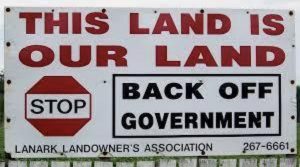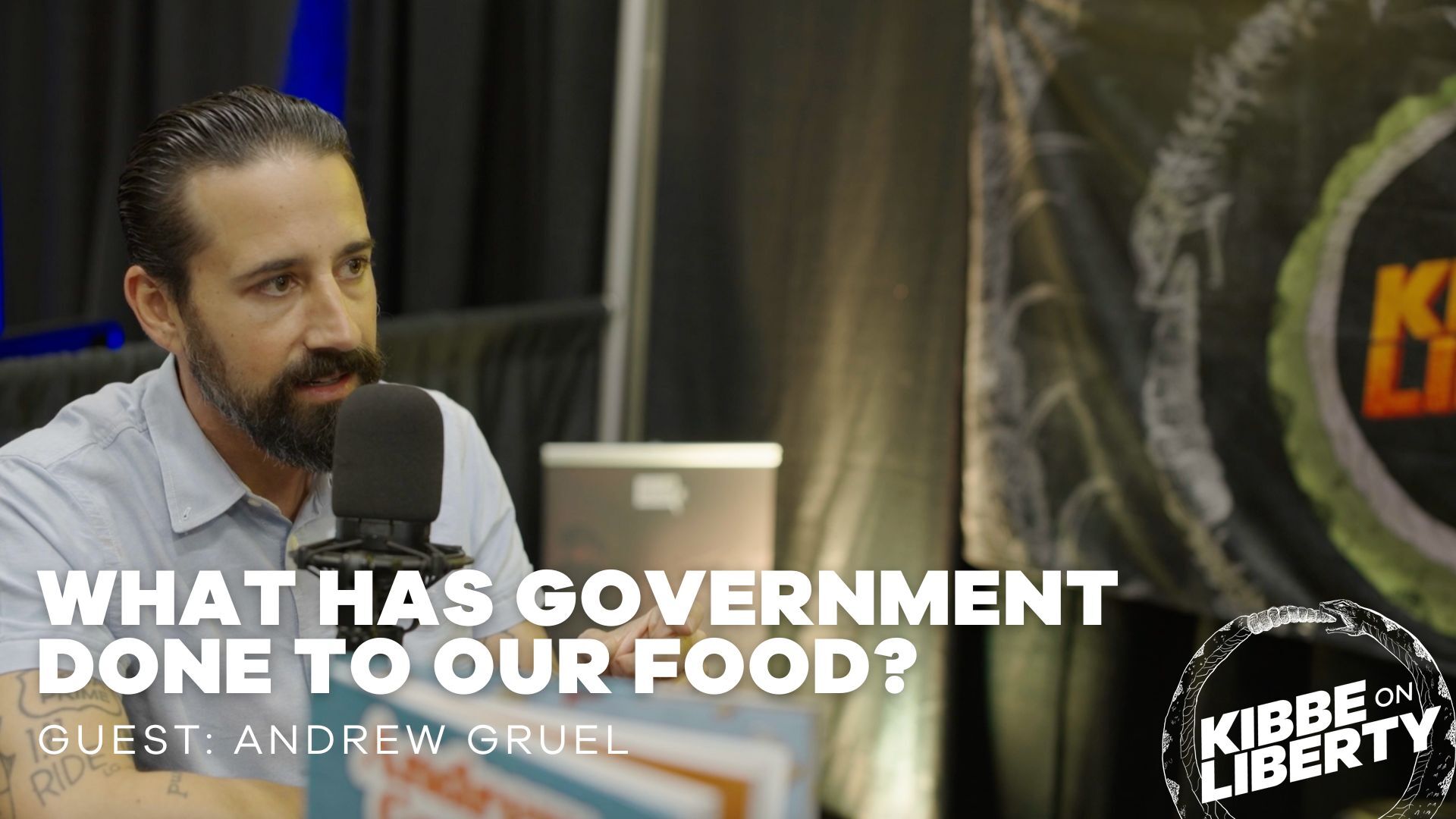
We’ve Got Some Decisions to Make
It’s September 2004. One hundred tractors line the highway at an intersection on Ottawa’s western fringe. A middle-aged man in red suspenders shouts into a bullhorn atop a wooden flatbed trailer: “There’s something wrong when some bureaucrat in Kemptville can sit in his armchair earning $70,000 and say, ‘I don’t care, Mr. Farmer, if you lose $10,000 in crops.’”
 Around him are people of all ages, some wearing rubber boots, others holding babies, most dressed in overalls. These members of the Lanark Landowners Association (LLA) have pledged to do whatever it takes, including jail time, to be heard. They hold signs: “This land is our land—Back off, government.”
Around him are people of all ages, some wearing rubber boots, others holding babies, most dressed in overalls. These members of the Lanark Landowners Association (LLA) have pledged to do whatever it takes, including jail time, to be heard. They hold signs: “This land is our land—Back off, government.”
That was the Lanark Landowners Association protests 18 years ago. It’s a story of farmers losing upwards of $50,000 in crops annually to deer, or discovering that their entire farm was deemed “buffer” for an “aggregate resource” on the neighboring land, or deemed “wetlands”… but still paying taxes on it. It’s a story of sudden rule changes, of sawmills and sugar bushes going out of business after the legal definition of “industrial” was redefined as “any raw product processed into another product.”
Some things never change.
It’s all reached biblical proportions. Try this one: “So the same day, Pharaoh commanded the taskmasters of the people and their officers, saying, ‘You shall no longer give the people straw to make brick as before… And you shall lay on them the quota of bricks which they made before. You shall not reduce it, for they are idle… Let more work be laid on the men.’”
Now, for the Trudeau government, it’s food without fertilizer.
Let’s pick a number out of the air. 30% sounds good. Thirty percent of all nitrogen emissions. What the starting point is doesn’t matter. It doesn’t matter what the farmer has been doing, how hard he is trying to cut back on fertilizer, or how much food is produced per pound of said fertilizer. It doesn’t even matter that he produces something, say, essential, like food.
The 30% is just a nudge in the right direction, anyway.
As rampant centralization continues and the bureaucratic Tower of Babel rises, and as the myths of progress, human improvement, and the saving power of technology spur us onward with the Vogue class leading us to the Promised Land, we are rapidly losing the very diversity that these worldchangers preach about. In January 2001 when Ottawa became the farming capital of Canada with 90% of its land in agriculture, centralization meant applying the same bylaws across the board. Farmers were not allowed to kill predators, they couldn’t burn without a permit, they were subjected to noise restrictions, and woodlot owners faced reams of paperwork and lot inspections before they could cut firewood. Suddenly shooting a raccoon in Centretown was the same as a farmer shooting a pesky groundhog. Two thousand dollars per week stolen from your business was acceptable, for the (rural) environment’s sake.
It was the new norm for amalgamated farmers.
Eighteen years later, welcome to what Josias van Aartsen has called “New York on the North Sea”: The Tristate City, Holland. The brain child of investor, planner, and philanthropist Peter Savelberg, this combination of lands in Belgium, Holland, and Germany will be an area that runs roughly from The Hague and Amsterdam down to Brussels and over to Cologne, with a population of 45 million people, eight universities, the new home of the EU and a plethora of multinational corporations. The “sustainable urban powerhouse” will all be linked by bullet trains and connected to Europe’s Hyperloop.
In the pitch we are told, “Dutch cities are far too small to compete with emerging Asian cities.”
It’s a new world, this kum ba yah circle. We are no longer constrained by the borders of separate cities or separate nations. Under the banner of… wait for it… “Together is better” the project will uphold the laudable goals of “Sustainable development, no more poverty, zero hunger, good health and well-being, quality education, gender equality, responsible consumption, climate action, peace, justice and strong institutions…”
Seriously. It’s in the brochure, man.
Said one promoter: “The future lies in the hands of innovative minds who are capable of combining creativity with digital technologies.”
Why wouldn’t I give over my rights, my land, for that? World peace. A controlled and quantified environment.
I’m running to the altar in tears.
Ahem: “Didn’t the Dutch government say this was all about cutting nitrogen and saving fish?”
It’s not about the nitrogen. It’s wolves in New World sheep’s clothing.
Vandana Shiva, Indian ecological activist, puts it succinctly: “The same people who caused the problem are pushing these farmers to solve it. It’s the ultimate colonization that’s happening. A billionaire class land grab.”
We have to choose. And our comforts come at a cost.
The bullying ends when people refuse to give over the resources that are supporting the bullies.
Gene Sharp would have some good questions: How willing is the population to withdraw the sources of power, to turn off the taps, or slow things down? How can people support each other without the reliance on government and experts? How can parallel societies, microeconomies, and co-ops be established, so as to drain the reliance on those with whom the relationship is far from reciprocal—you think Monsanto cares?
And the question we seldom ask ourselves: Where do our own strengths lay?
Distributism argued that personal freedom belongs to us by our very nature “and that this freedom can be safeguarded only if there is widespread personal ownership of all forms of property, particularly of productive property.”
It was an agrarian movement in the thirties and forties based on the belief that large concentrations of wealth, capitalism as the rule of the moneylender, and industrialism as the rule of the machine were the enemy. To them, our politics were corrupt and this would lead to the “servile state” in which we were “controlled by a clique of wealthy men.”
Whether it’s Distributists, the Haugeans in Southern Alberta, the Victorian Arts and Crafts movement of William Morris and Thomas Carlyle, or the Antigonish Movement in Nova Scotia in the 30s with its emphasis on food and housing cooperatives (and which diffused the communist movement in that province), there are examples abundant of people who chose to push back, take ownership when they saw it slipping away, and discovered their own resiliency, sense of agency, and community in the process.
We buy into Babel because it’s the easiest path. Is it worth the cost?
Ask forty thousand Dutch farmers.
Free the People publishes opinion-based articles from contributing writers. The opinions and ideas expressed do not always reflect the opinions and ideas that Free the People endorses. We believe in free speech, and in providing a platform for open dialogue. Feel free to leave a comment.



